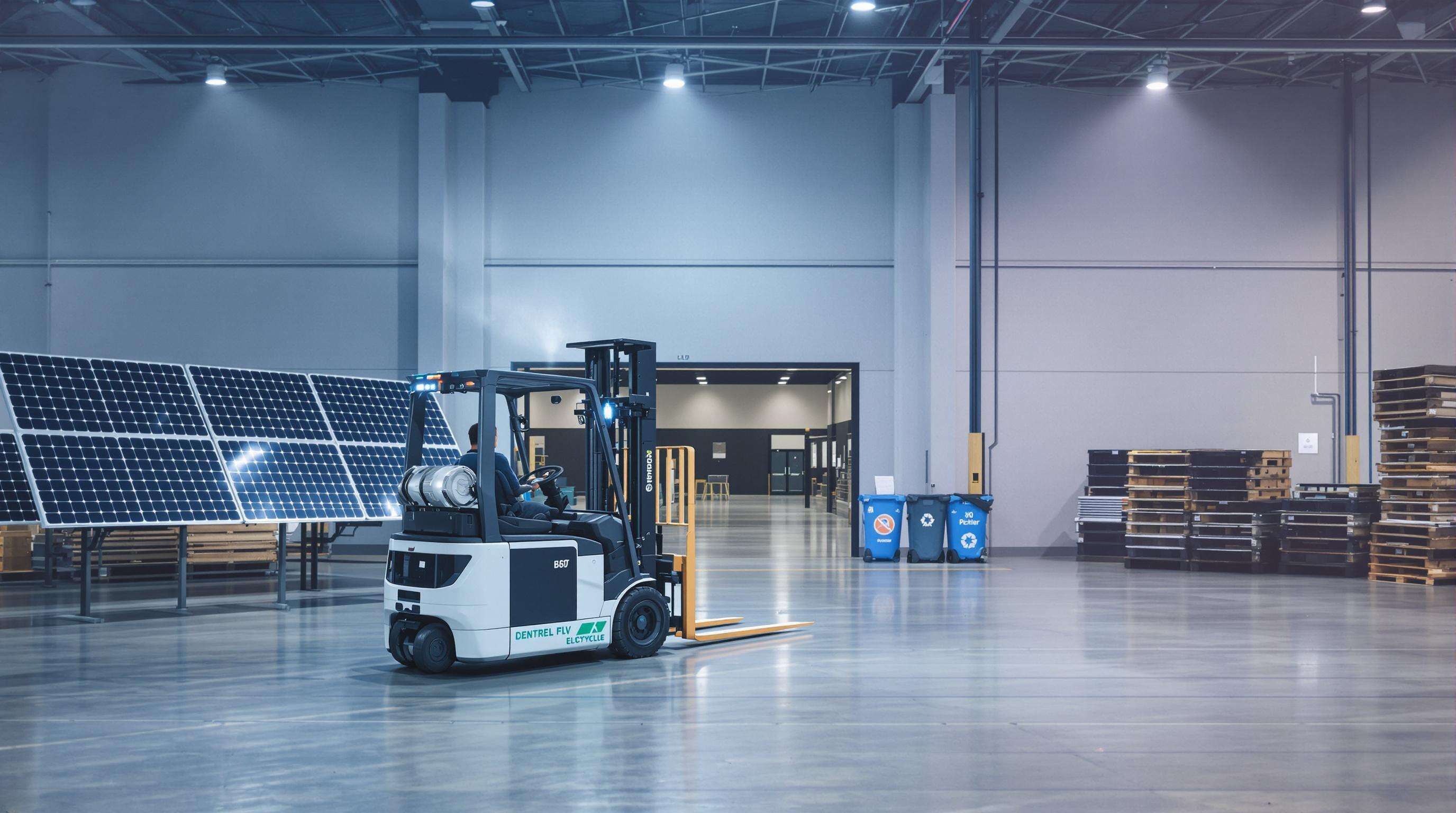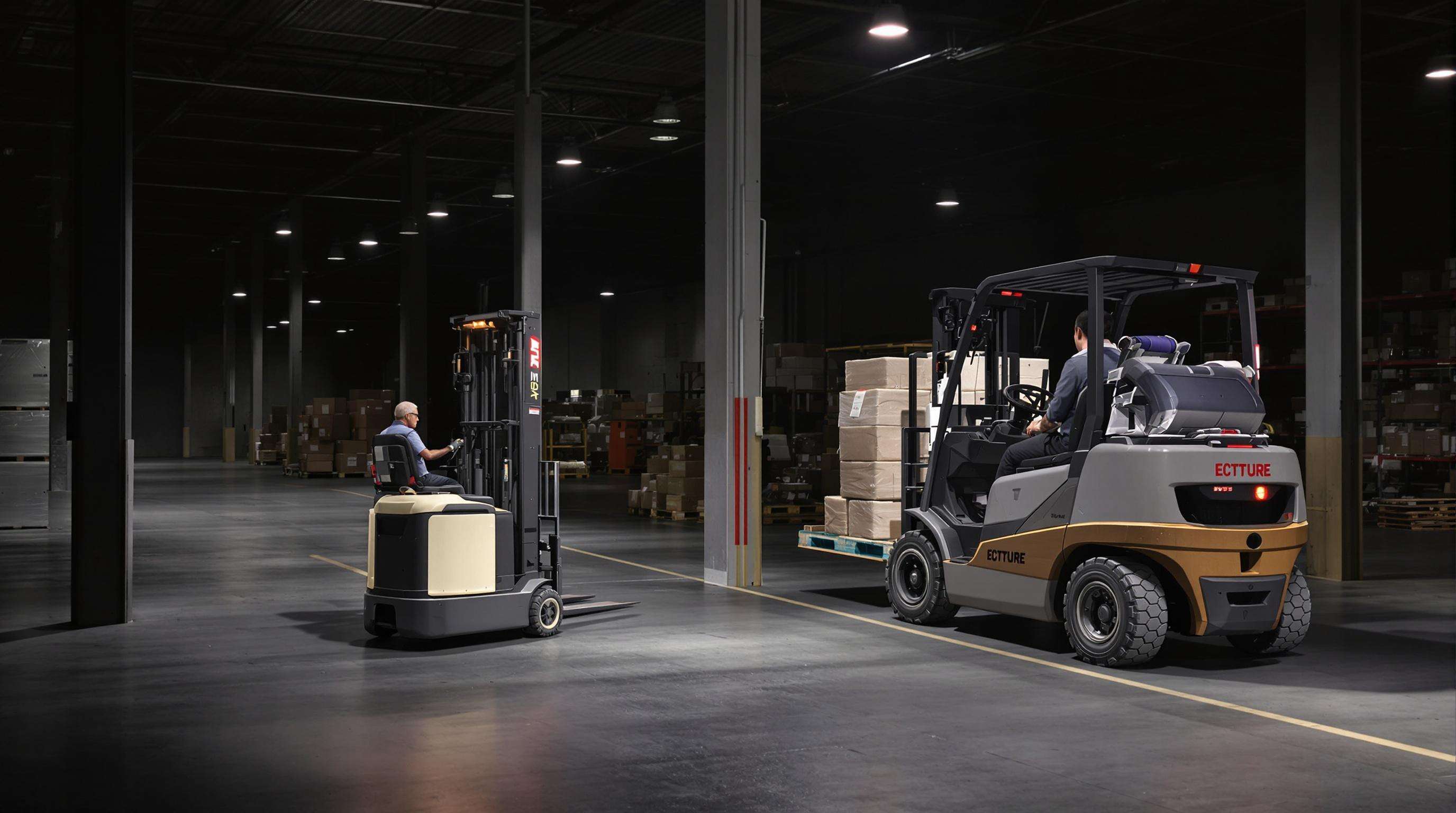Electric Forklifts Transforming Night Warehouse Acoustics
Noise Pollution Crisis in Traditional Night Operations
During night shifts, traditional combustion engine forklift trucks result in a hazardous working environment as their noise levels are similar to that of urban traffic (85-90 dB(A)). Occupational Fatigue When the machine and personnel spend longer time under the noisy environment and it is difficult for operator for maintenance, the operator may be subject to occupational fatigue, which in turn could lead to incorrect communication and task error rate. In occupational health studies, 78% of night-shift warehouse workers suffered from chronic stress associated with machine noise (Industry Report 2023). “Running electric forklift power minimises these risks by removing engine roar, meaning both staff morale and operational accuracy in after-hours is maintained.”
Decibel Comparisons: Electric vs. Combustion Models
Electric forklifts operate at 60-65 dB(A) — quieter than typical office conversations — while diesel counterparts exceed 85 dB(A) during heavy lifting. This 30% reduction in acoustic output allows warehouses to comply with stringent OSHA nighttime noise regulations (₠80 dB(A) over 8 hours). Key comparisons:
| Activity | Combustion Model | Electric Model | Human Equivalent |
|---|---|---|---|
| Pallet stacking | 88 dB(A) | 62 dB(A) | Blender vs. refrigerator hum |
| Horizontal transport | 82 dB(A) | 58 dB(A) | City traffic vs. whisper |
Community Relations Impact of Silent Technologies
Warehouses in urban corridors see an immediate 40% drop in noise complaints after switching to electric forklifts, according to data from the city’s municipal zoning code. Quiet operations also allow facilities to operate through the night without impacting nearby homes — a vital benefit for sustainable warehouse operations in mixed-use neighborhoods. 26% faster permitting for expansion projects in residential areas Neighboring Logistics Center Operations Reduced acoustic footprints due to the implementation of electric fleets (Urban Development Survey 2023).
Sustainability Mechanics of Electric Forklifts

Electric forklifts are redefining warehouse sustainability through zero-emission propulsion, reduced energy consumption, and lower operational costs. These machines leverage advanced lithium-ion batteries and regenerative braking to harmonize environmental goals with business efficiency.
Carbon Emission Reductions in Night Logistics
Warehouses generally depend on combustion engines to make deliveries at night, emitting up to 8.6 metric tons of COȂȂ annually per unit. Fork lift trucks power ed by electricity - com pletely emission-free For warehouse and outdoor storage ȂňȂcreating Ȃ¨locations, for instance Ȃ¨in the food industry, the ȂňȂuse of diesel forklifts and Ȃ¨vehicles with internal combustion engines with up to 5 tonnes of capacity can be practically ruled out. This is valuable for urban air quality compliance and enhancing indoor air quality overnight.
Lithium-Ion Power Advancements for Extended Shifts
Today’s lithium-ion batteries increase run-time by 45% over lead-acid batteries for 8 hours of continuous night-shift operation without recharging. These batteries fully charged in 90 minutes compared to 8 hours, lessens downtime and keeps its voltage constant. Their significantly longer life (7-10 years) and better weight to energy ration help in maxing out logistic centers operational window without a break.
Regenerative Braking Systems: Energy Recapture Data
Kinetic energy recovery through regenerative braking captures 15-25% of expended power during forklift deceleration. This recharges onboard batteries instantaneously, cutting energy costs by up to 30%. For high-volume night operations with frequent stops and starts, this system cumulatively saves facilities approximately $18,000 annually per vehicle.
Total Cost of Ownership: 5-Year Sustainability Metrics
| Cost Factor | Electric Forklift | Combustion Model |
|---|---|---|
| Energy Expenses | $7,200 | $14,500 |
| Maintenance | $3,800 | $8,900 |
| Emissions Compliance | $0 | $4,600 |
| 5-Year Total | $55,000 | $92,000 |
Electric models demonstrate 40% lower lifetime costs over combustion alternatives, with ROI achieved within 24 months. Reduced maintenance needs and zero fuel dependency further position them as sustainable investments for high-traffic night operations.
Operational Excellence with Core Electric Forklift Designs

3-Wheel Maneuverability in Narrow Night Aisles
Three Wheel Electric Forklifts Transform nighttime shipments by shrinking the turning radius to under 80 inches—even in aisles as narrow as 11 feet. This sleek construction eliminates the conventional risks of blocking when visibility is hampered at night. Industry research supports these units preserve their full lifting capacities until 6,500 lbs, in tighter operating areas with internal combustion competing competitors. Less space required means a much higher density is achieved, with less chance of collisions for night-time working.
4-Wheel Cushion Stability for High-Velocity Operations
Features: Quad wheel electric cushion tire trucks are ideal for high-speed long distance runs, heavy loads and high stacking electric cushion tire lift trucks with quad wheel drive are ideal for rugged outdoor applications such as transporting lumber C: Quad wheel forklift Characteristics Details: Electric quad wheel forklift trucks provide key support during high-speed night time load handling operations. The built-in vibration reduction suspension dampens feedback from rough terrain when traveling at speeds over 8mph to minimize load shift when quickly transferring materials. Vibration Reduction Vibration reduction system reduces hand/arm vibration (H/AV) for increase productivity and safety; Reduces H/AV up to 30% versus pneumatic tires during accelerated night operations. This stability also provides safer turning and quick stopping while transporting fragile loads in poorly lit warehouses.
Mid-Size Electric Forklifts: Speed vs. Payload Paradox
Mid-sized electric forklifts, however, expose the basic speed versus lifting capacity tradeoff over long shifts. Top speeds are reduced by 22% when carrying loads exceeding 4,000 lbs because of battery usage and safety procedures. The latest power management packages can even automatically adjust acceleration curves based on live load weight measurements. This paradox is resolved by operators with shift-specific routing decisions, which favour fast traffic or the carrying of heavy items in the overnight workloads.
Night Shift Productivity Case Studies
The transition to electric forklifts generates measurable productivity gains during nocturnal warehouse operations. Third-party validation emerges through case studies across logistics segments, where silent operation and reduced maintenance consistently elevate throughput.
Automotive Supplier: Output Increase from Shift Transition
One of Europe’s largest car parts manufacturers observed an 18% increase in productivity when they switched over night shift work to pure electric trucks. Increased operator awareness—attributed to 50% decreased ambient noise levels—maintained the workflow without slowed operation due to fatigue. Removing the need for combustion engine fumes during operation stopped active lift times for an extra 25 minutes of shift by keeping the power on in 24-hour operations and No Refuel requirements, increasing assembly-line output directly in low light conditions.
Retail Distribution Benchmark: Maintenance Downtime Reductions
Leading retail distribution centre see a 30-45% reduction in incidents of unplanned maintenance with electric forklift fleets dedicated to overnight operations. Whilst combustion engines required nightly fluid checks and frequent exhaust system servicing, electric drivetrains had 97% operational uptime over two shifts, thanks to a much simpler motor architecture. This dependability shifted thousands of hours of maintenance per year into inventory processing, squeezing fulfillment windows at minimal labor cost, no less.
The Cold Storage Dilemma: Battery Performance in Sub-Zero
Cold storage environments have historically limited battery life until lithium-ion innovation transcended all-weather restrictions. One frozen-foods distributor in the Nordic region ran full 8-hour shifts at ―20°C (―4°F) with thermally protected lithium batteries that continued to perform at 90% or better efficiency, while lead acid power solutions could last no longer than two hours. Continuous operation is made possible by intelligent cold-standby systems which keep the viscosity of the electrolyte at the optimal level even before start-up, avoiding cold start-up time as it is normally expected below zero.
Implementing Electric Forklift Revolution
Charging Infrastructure Strategy for Non-Stop Shifts
Roll-out and deployment of continous-operation charging infrastructure must be in line with policy expectations. During break times, quick charging on opportunity is also possible, so electric forklifts can be recharged during work breaks. You should also have at least one charging bay for every 4 or 5 machines, and place these near high-traffic areas of your facility. Rapid-charging can bring the battery charge back up to a maximum of 80% in less than 25 minutes allowing for continuous operations. Heat monitoring device to avoid excessive heating in fast cycles. Stage the charging of rotation for 24 hour operations so that equipment is available and battery life is increased by 25%.
Training Protocols for Large Electric Forklift Specialists
Operators converting to high-potential electric forklifts also need unique training. Ideally, curriculums will include physics of load weighing of vehicles with high centers of gravity, kinetics of regenerative brake systems and procedures to test battery voltage. Interactive Modules should also take into account specific stability issues in very narrow-aisle applications. In general OSHA-compliant training cuts down equipment damage by more than 30% in the first six months. Further certification guarantees that technicians can diagnose errors in the energy recovery system and service high-voltage electrical components without running the risk of receiving an electric shock.
FAQ
Why are electric forklifts better for night shifts?
Electric forklifts create a quieter work environment due to lower decibel levels compared to traditional combustion engines, reducing the risk of occupational fatigue and errors.
How do electric forklifts impact community relations?
They significantly lower noise pollution, reducing community complaints, and facilitate easier permit processes for warehouse expansions in residential areas.
What are the cost benefits of using electric forklifts?
Over five years, electric forklifts result in 40% lower lifetime costs than combustion models due to decreased energy and maintenance expenses, as well as emissions compliance savings.
What advancements have been made in forklift batteries?
Modern lithium-ion batteries offer increased runtimes, faster charging, and better performance in extreme temperatures, enhancing efficiency and reducing downtime.
How important is training in transitioning to electric forklifts?
Training is crucial for safely and efficiently operating electric forklifts, involving comprehensive understanding of the new systems, battery management, and safety protocols.

